YORKSHIRE DARTBOARD
Yorkshire - Regional Dartboard
Famous for Yorkshire Puddings, the Dales, the Angle of the North Sculpture, and one of the oldest UK Regional dartboards still played upon today, the 'Yorkshire Dartboard'. The Yorkshire Dartboard is a forerunner of the now standard London dartboard, or as some may call it, the 'Clock' dartboard. The Yorkshire Dartboard differs from the standard dartboard most of us play on as it has no Treble or Outer Bullseye scoring area. The bullseye still scores 50 and is smaller than a standard bullseye on a standard dartboard.
It wasn't until the late 1920s that the trebles section was added to the 'standard dartboard', which is the most popular dartboard in the world today. However, the 'standard' dartboard was not an overnight success in the UK. Initially, it had to compete with other existing target boards played across the United Kingdom. These have come to be known as 'regional dartboards' and were usually named after their location of origin. For example, the Yorkshire Doubles DartBoard, Kent Doubles, the London Fives and the Manchester Log-end Board.
The Yorkshire dartboard has a 'standard' numbering system without trebles. The Manchester 'Log-end', The London 'East End' (Narrow Fives) and Ipswich (Wide Fives) Dartboards have different numbers systems. All these boards are still available and played on in the UK (c 2023). However, they still remain regional and are played on less than the standard dartboard.
When mentioning the Yorkshire Dartboard, I should also mention the Irish Black and Lincolnshire Dartboard.
The Irish Black Dartboard is the same as the Yorkshire Dartboard. However, unlike the Yorkshire Dartboard, the playing surface is totally black, not the standard Black, Red, Green, and Natural as seen on the Yorkshire Dartboard. However, the rules remain the same. The Lincolnshire Dartboard again looks the same as the Irish Black, but 'ORIGINALLY' it is wider than a Yorkshire or standard dartboard at 15 inches diameter to the double outer rim. The Yorkshire and Irish Black are both 13 ¼ inches.
A version of the 'Lincolnshire' dartboard is still made, but it now conforms to the standard size of the Yorkshire Dartboard. For the history buffs, the Lincolnshire league struggled to find a new supply of the 15in version when their last one stopped supplying. However, Winmau helped by providing a black version of the Yorkshire Dartboard for the Lincolnshire League to use. In turn, they labelled it a 'Lincolnshire Dartboard.' However, purest will still refer to this size dartboard of this construction as an Irish Black!
It is also worth noting that Kent is the only other area where a doubles board is traditionally strong. Again the board was originally larger than the Yorkshire Dartboard, believing it to be a replica of the Old Lincolnshire Dartboard. However, this has since changed to the size of the Yorkshire Dartboard.
Illustrations of both the Irish Black and the Lincolnshire dartboard are also shown here. Both boards have been made in the past from wood and sisal. The traditional jet-black dye used for the wooden construction was carried over to the sisal boards. Black dye was used so the wire dividers could easily be seen.
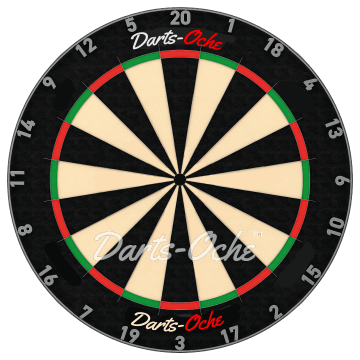
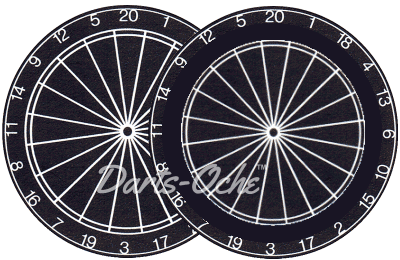
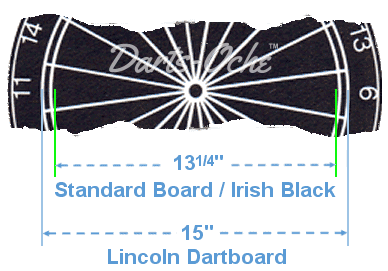
Indoor League
In the 1970s the Yorkshire dartboard featured in the first series of 'Indoor League' before it was replaced by the now familiar London 'Clock' board featuring the treble ring.
Indoor League was a Yorkshire TV daytime TV program that featured pub games played across the UK: Darts, Table Skittles, Ally Skittle, Bar Billiards, Pool, Table Football, Shove Ha'penny and Arm Wrestling!
The 'Indoor League', along with coverage of the News of the World Individual Championships, started a bigger interest in darts on our television screens. In 1976 the BBC approached the BDO and said they would broadcast a World Championship event. The rest is history.
Indoor League not only helped darts but also introduced us to two of the most famous TV darts commentators of the past, Dave Lanning and Sid Waddell, who sadly are no longer with us.
Indoor League Darts Tournament Winners
1972 Colin Minton (beat Charles Ellis) (Yorkshire Dartboard)
1973 Tommy O'Regan (beat Alan Evans)
1974 Leighton Rees (beat Alan Evans)
1975 Conrad Daniels (beat Cliff Inglis)
1976 Leighton Rees (beat Charlie Ellix)
1977 Tony Brown (beat David Rocky Jones)
A note of interest regarding the Lincoln and Irish Black Dartboards
It is worth noting handmade Lincoln, Irish Black and the Manchester log-end dartboards were supplied by a Manchester Dartboard supplier Perrigo and the differences were plain to see. Perrigo has since stopped production of the wooden dartboards. However, some of the boards are still made and can be purchased elsewhere.
It is also worth noting that a well-known dartboard manufacturer Winmau also makes a black dartboard named a Lincoln. However, as detailed above, the board is of standard size and incorrectly gave the ‘Lincolnshire’ name, but approved by the Lincolnshire Dartboard League at the time. However, referencing the Guinness Book of Darts by Derek Brown, the board should have been named an Irish Black. (Further ref and first-hand experience via Perrigo, Droylsden, Manchester)
Like all counties in the UK, Lincolnshire holds onto tradition as this makes its identity. Although the traditional Lincoln dartboard may not be readily available, it is not true that the Lincolnshire Dartboard has reduced in size, as some might have you believe.
If the doubles board is played in the county of Lincolnshire on a standard-size black doubles dartboard, they have adopted an ‘Irish Black’. They should not be given the name ‘Lincolnshire’ Dartboard, regardless of what some advertising or other writers might have you believe.
Yorkshire Dartboard Set-up and Rules:
The height and throwing distances for the Yorkshire dartboard differs than that of a standard dartboard.
The Yorkshire dartboard is hung so that the centre is 5ft 6ins (1.676m) from ground level, the throwing line or 'oche' is 7ft 2ins (2.184m) from the dartboard face at ground level. The diagonal distance from the centre of the bull to the throwing line at floor level is 9ft (2.743m).
The Yorkshire Dartboard: Some may disagree with the set-up I have listed above and this may be due to changes seemly adopted in parts of Yorkshire but not necessarily all. The information I have gathered from Yorkshire and Professional Dart players confirm this set-up, however, I am aware that some set the Yorkshire board up as per a standard clock board.
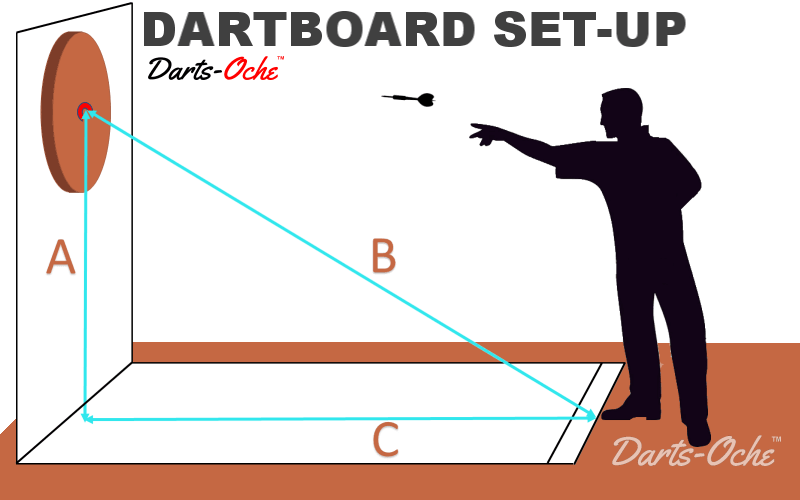
| A: Height to Centre Bull | B: Centre Bull to Oche | C: Throw Distance |
| 5ft 6ins / 1.676m | 9ft / 2.743m | 7ft 2ins / 2.184m |
Rules / Games 701, 501 or 301
The order of play is either determined by a toss of a coin or by each player throwing for the centre bull the nearest being the player that throws first. The rules here can vary depending on the league you may be playing in; the local rules should be observed at all times.
When throwing for the bull, if the first thrower hits the centre bull or outer bull the dart is usually removed before the second player throws. If the second player hits the same as the first player then the bulling-up procedure starts again. If the first player's dart does not hit either the centre bull or outer bull then the dart remains in the board until the second player throws. If the first player's dart is obstructing the bull the second player may request the marker/referee to straighten the dart. (See local rules)
Once the order of play has been determined the winner will start leg one and odd legs after that. The loser will start leg two and even legs thereafter.
Any standard darts may be used.
A throw consists three darts except were the game is finished in less.
Darts cannot be re-thrown this includes darts that miss the board and darts that bounce of the board wiring system. Only darts that have their points touching the scoring area of board score.
A player may be told, if he asks, what number they scored, or what number required for the game, by the score announcer, but not the outshot.
If the number required for the game is exceeded in the course of a throw, throw ceases, and no account is taken of the score obtained during that throw.
There is only a bull (50) and no outer bull on a Yorkshire Dartboard.
The game is to score 701, 501 or 301 as previously agreed.
Scoring
Generally, each player’s score must start and finish a game with a double (The narrow outer ring of the board). Competition games, however, are usually played with a straight start (no compulsory double) but with a compulsory double to finish.
The first throw is deducted from the player's start number e.g. 501 and then from the subsequently reduced total. The scorer should show both the score obtain for the throw and the reducing total remaining.
For fast practice, games play 301. For league and competition 501 and for pairs 701. In fact, any agreed starting number can be used but usually, the number should end 01 the reason for this is so a player must hit another part of the board other than the 20’s segment in order to win a game.
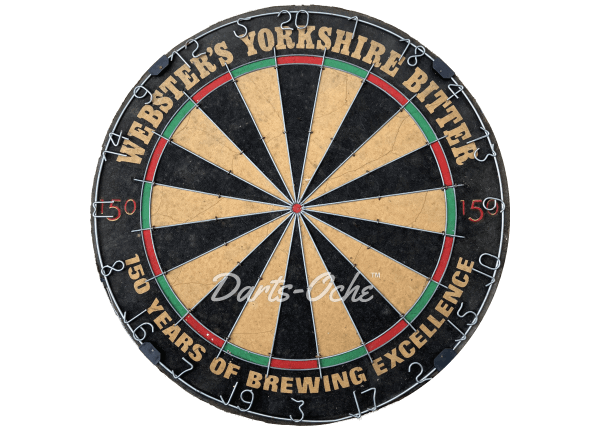
Yorkshire Dartboard Get's the Webster's Brewery Endorsement
Webster's Yorkshire Bitter was launched in 1982, but Samuel Webster and Son's Brewery dates back to the early 1800s. It was founded in 1820 by John Mitchell, and by 1838 the Brewery was operated by Samuel Webster. The Brewery's history indicated Samuel Webster bought it circa 1860 and registered it in 1890. Watney Mann Ltd later acquired the business in 1972. Webster's was later amalgamated with Wilson Brewery Ltd in 1985. Hence the 150 years of brewing excellence as shown on the Yorkshire dartboard here suggests the dartboard was made no earlier than 1982, but most likely 1988, which co-insides with 1838.
Webster's Brewery sponsored the BDO UK Open Darts Championships in 1989, 1990 and the World Matchplay darts tournament in 1995, 1996.

